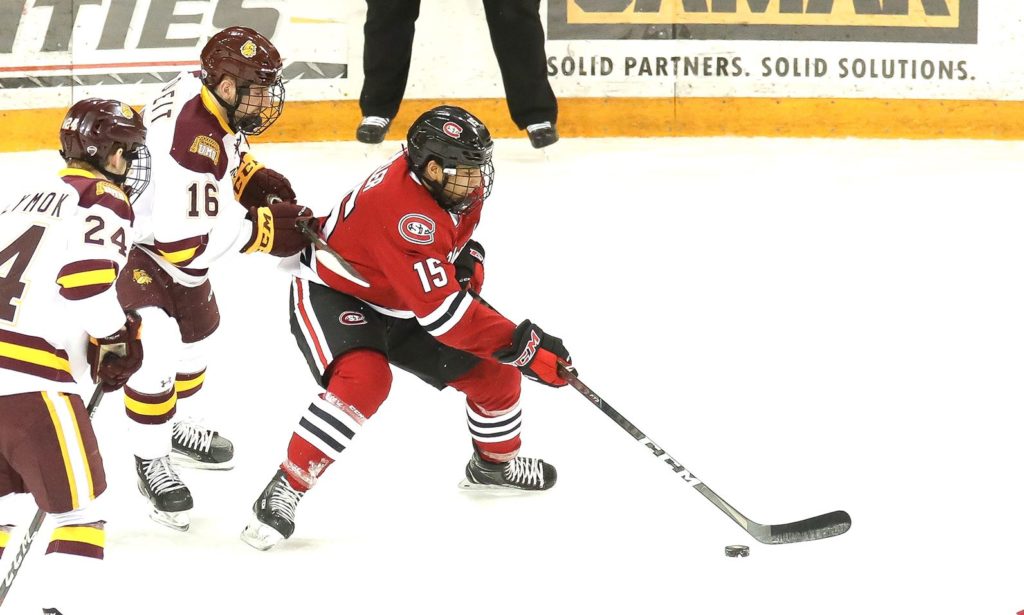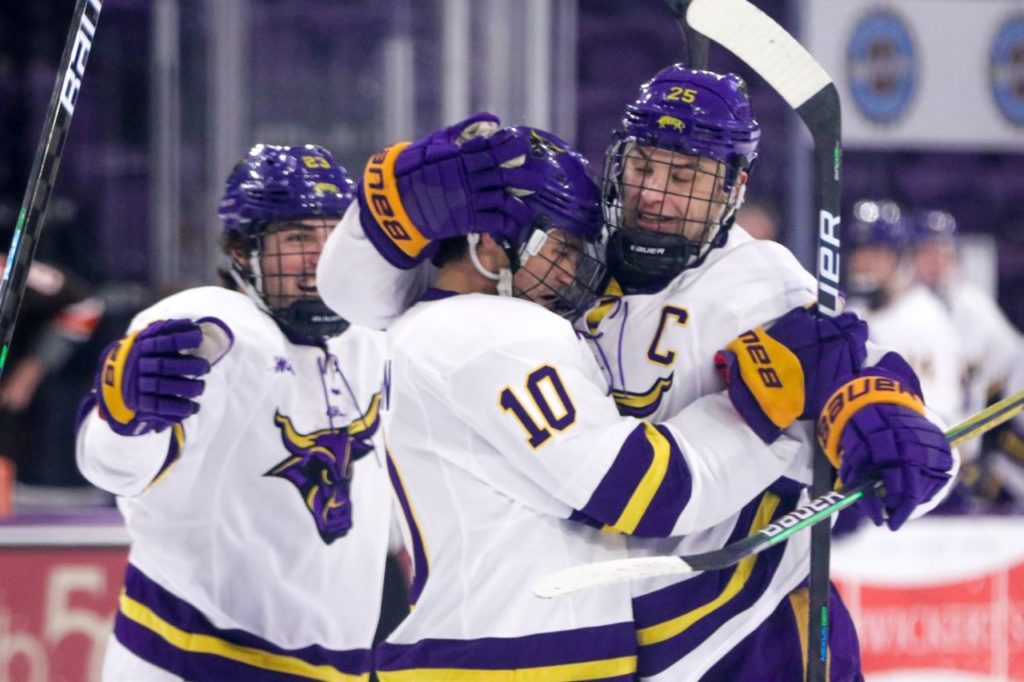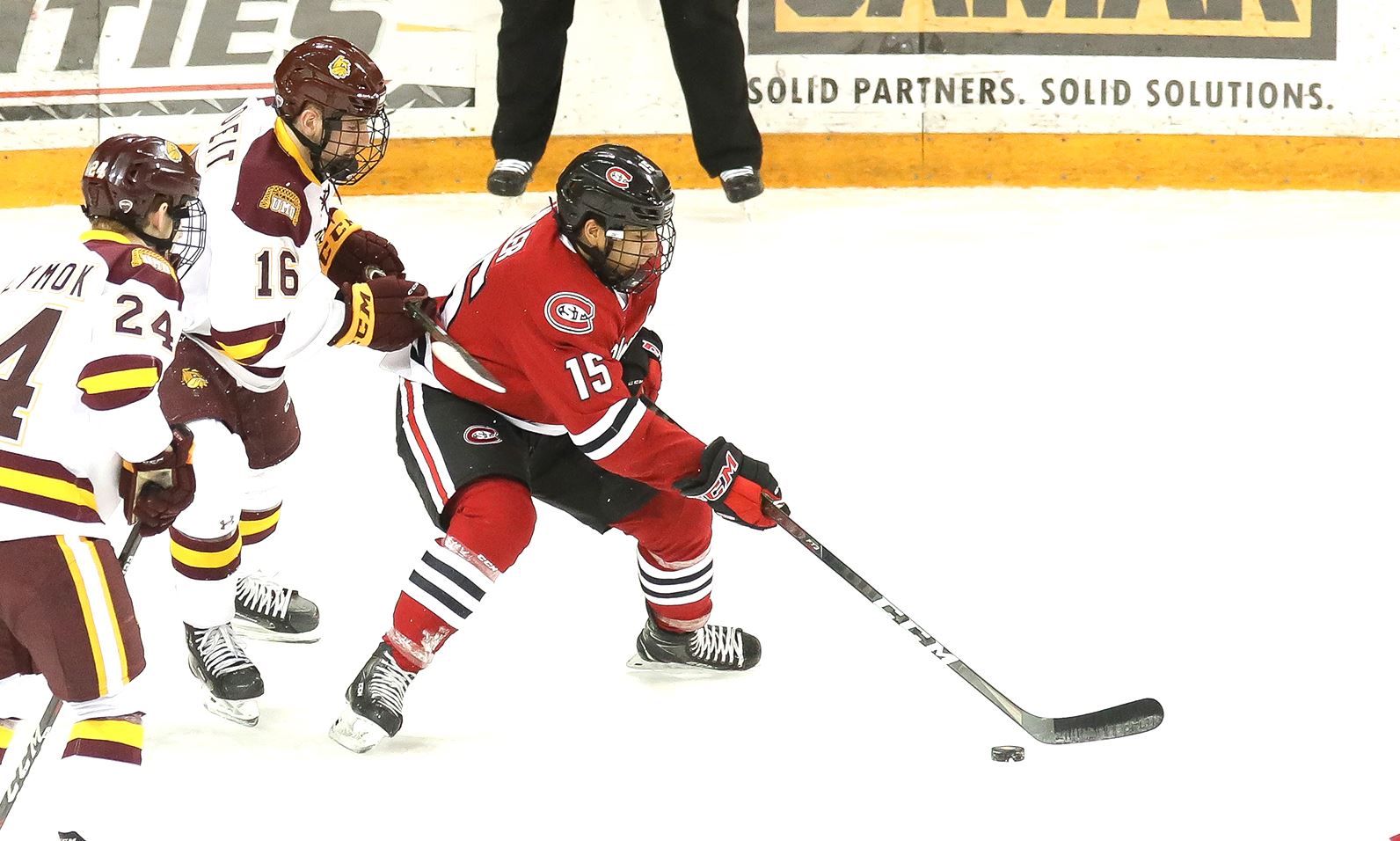
Minnesota has called itself the state of hockey for years now, but even someone who rolls their eyes at the saying would have to admit that it rang true in college hockey this season.
What else would you call a state that put all five Division I programs into the 16-team postseason tournament and will make up 75 percent of the Frozen Four?
“You’re talking to a guy that the reason I’m maybe standing here after a long NHL career and two Olympic teams, or whatever you want to say, I’m here because Herb Brooks came back to Minnesota after coaching in the NHL and obviously winning the gold medal in the 1980 Olympic team and said, ‘You know what, there’s just not enough Division I opportunities in Minnesota for Minnesota kids,’” former St. Cloud State defenseman Bret Hedican said. “For him to come back and start this wave, an opportunity for Minnesota kids to have move Division I opportunities, at St. Cloud, you’re looking at the fruits of his labor. He’s got to be smiling right now looking down at three of the top four teams in the finals and five of the 16.”
St. Cloud State, Minnesota State and Minnesota Duluth will play in the Frozen Four on Thursday. It’s the second time one state has sent three teams after Michigan did it in 1992.
It’s the first trip to the Frozen Four for the Mavericks, who earned their way by beating Minnesota 4-0 a day after picking up the program’s first NCAA Tournament win. The weekend was fun to watch for Ryan Carter, who skated for Minnesota State for two seasons from 2004-06 before moving onto the NHL.
“I think the resiliency of the club is something that’s special,” Carter said about the Mavericks. “The words togetherness, teamwork, do this as a group, sometimes that gets thrown around a little too loosely but, if you look at this team, they truly are a group that’s come together. (Mike) Hastings, too, for a long time he’s been great at developing leadership and the right culture in that program.”
Carter didn’t play for Hastings but said that the Mavericks’ bench boss has been impressive during his spell at the university and that postseason success was bound to happen.
“I’ve been very impressed with how he’s incorporated alumni and tried to, not only create a good culture inside that locker room for their program, but for everybody,” he said. “I hear that he’s a fantastic motivator. He hasn’t had to motivate me to play hockey, but I get excited listening to him. You can see his passion, for hockey, for winning, but, most importantly, for his student athletes.”
Hastings is far from the only lauded head coach from the state heading to Pittsburgh. When Alex Stalock arrived on campus at Minnesota Duluth, the Bulldogs were coming off their third Frozen Four in program history, but the first of the new millennium. Scott Sandelin didn’t have three national titles to his name like he does now, but success was on the horizon.
The Bulldogs are now in their fourth straight Frozen Four and are seeking their third straight title.
“Not only players, but coaches go through ups and downs, too, right?” Stalock said. “He got a group there in 2004 and he saw that it took and what type of team it takes to get there, not only on the ice but off the ice.
“It takes a mix of a lot of different skill at that level to be successful. He’s done a great job of recruiting not only high-end top end guys that leave the program after a year or two but also guys that are huge factors and stay three or four years.”
Head coaches don’t usually work on the X’s and O’s with goaltenders, but the South Saint Paul, Minn., native took something from Sandelin that had nothing specific to do with his position.
“He wanted you to work, that was it, go in and work your butt off,” Stalock said. “Everything’s going to work out that way.”
Stalock, who left Duluth in 2009 after three seasons to sign with the San Jose Sharks organization, said that all the alumni have reveled in the recent success of the program.
“It’s fun to see and I know from going back for some of the golf tournaments in the summer that anyone that shows up there, all the Bulldog alumni, they wear the Bulldog with a ton of pride right now and the program’s probably the strongest it’s ever been,” he said.
St. Cloud State finds itself in the second Frozen Four in program history. It’s the first for head coach Brett Larson, who took over the reins in 2018. To intertwine things even further, Larson was a longtime assistant under Sandelin at Duluth before heading West.
“I can’t even tell you how proud I am of Brett Larson and just the team in general of what they’ve done this season,” Hedican said.
The Huskies, who were dominant against Boston University and Boston College last weekend at their regional, will face the Mavericks on Thursday. The Bulldogs facing off against the one non-Minnesota team, Massachusetts, will follow.
Hedican, who played for St. Cloud State for the 1990-91 season, enjoyed a solid 20-year NHL career. He currently resides in California and is a part of the San Jose Sharks broadcast, but the Huskies are still a large part of his life.

“I just graduated college in December, during the pandemic,” he said. “I decided to finish up my degree and ended up getting a Bachelor of Elective Studies and a Minor in Mass Communications. Matter of fact, my minor just went through last week. My relationship with St. Cloud has always been close, I’ve always been part of the alumni and reaching out to players and letting them know how important they are.”
Not lost in three Minnesota teams making the Frozen Four is that none of them hail from Minneapolis. Both Stalock and Carter stopped short of dancing on the Gophers’ grave, Carter’s current jobs as color commentator for the Minnesota Wild on Bally Sports North and as a digital content producer for Wild.com do require him to appease to a statewide audience after all, but both were proud of what the state schools have accomplished.
“I grew up wanting to be a Gopher and then I grew to always want to beat the Gophers because they were the measuring stick for a long time,” Carter said. “I still think that they’re a marquee program and a program that everyone wants to play at. That said, you have to give respect to the other state schools around.
“It’d be great if it was four Minnesota schools, and I’d welcome the Gophers in, I’ve gotten over my desires to beat them, but it’s fantastic for the state schools to get that respect.”
Stalock said there probably wasn’t many tears shed for the Gophers up North but added that the more exciting aspect was Mankato breaking through and not Minnesota losing.
“When you’re up in the 218 area code, it does put a little smile on your face that the Gophers aren’t the ones moving on,” he said. “I have relationships with the players and staff down at Mankato, I was excited to see them not only get their first tournament victory but move on. It’s a team that’s been knocking on the door for years to make that next step, and they did. Now is it going to be a situation where they go on a run now?”
Hedican, who played during an era where three teams from Minnesota advancing and one not being the Gophers would have been borderline unthinkable, gave credit the hires that the schools have made over the years. He also noted that there were multiple ties to St. Cloud.
“It says a lot about the people they’ve elected to coach,” he said. “Mike Hastings at Mankato, (Tom) Serratore who spent a lot of time at St. Cloud, Hastings was a St. Cloud Huskies. Brett Larson learned a lot at Duluth how to win, and now he’s at St. Cloud. You’re seeing these Minnesota coaches all, really, under the umbrella of St. Cloud State which, for me, also really speaks to the culture that I’m really proud of at St. Cloud.”
